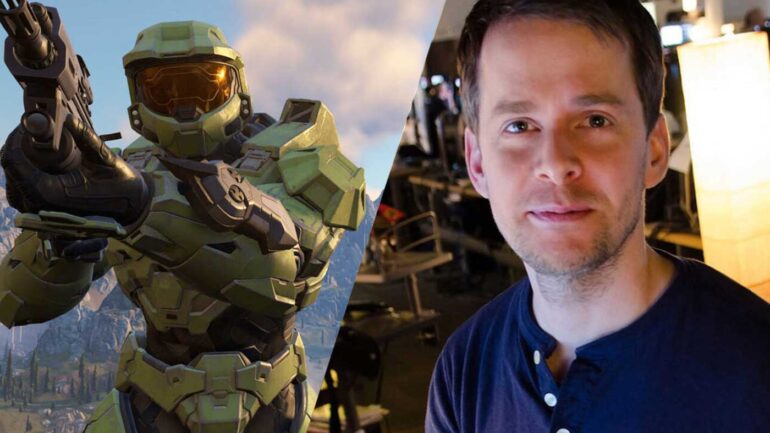Along with previewing the first few hours of Halo Infinite, we were fortunate to speak with the game’s Creative Director, Joseph Staten, who returned to the franchise after spending a decade as a developer-turned-fan.
In our chat, Staten spoke candidly about his return to Halo, the challenges the team faced after the game’s infamous delay, and how the team worked hard to deliver a 20th anniversary gift to remember. Most gift fine china, but 343 Industries delivered the game’s free-to-play multiplayer experience almost a month early.
I’d firstly like to ask you about your return to the Halo franchise and how you found that experience because it had been a while since you’d worked on it?
JS: It was a good amount of time, you know, probably ten years, maybe even a little bit more. I’ve never really lost touch with the franchise. I certainly played Halo 4 and Halo 5 and I’ve jumped in once in a while to help with small things. Whether that’s writing a short story or just going out to dinner, or having a quick meeting with people and offering them feedback.
But my time, the help I offered was pretty small and intermittent for sure. Me jumping back in full time was a very, very different thing. I mean, Halo Infinite – we call it a spiritual reboot, but it feels a lot like the original Halo games. I mean, there’s a classic Halo feel to it but with some really fun modern innovations.

Was it challenging coming in three or four years into development, I imagine, and would you say the vision or story changed at all after you joined the team?
JS: Well to some extent, yes, it was challenging. But only because of a variety of things, not the least of which being a global pandemic where everybody had gone to safe places at home or different places around the country. Meeting a big team remotely was challenging in terms of getting to know people and building relationships. But at the same time, what made it a lot easier is I think it was a known quantity for the team, I’d work on Halo games. I wasn’t exactly a totally new person.
I knew a lot of the leadership in the team, so it was easy for me to reestablish those relationships. And then to just jump into the game that I was very familiar with and feel like I could hit the ground running with a fresh set of eyes and offer some immediate suggestions to the team.
You know, one of the first things that we talked about as a team was: “What are our principles?” You know, what do we really stand for? And what’s important to us and what kind of time is it gonna take to live up to those principles? And that led to a discussion that eventually made us shift out by a year. So there were some hard decisions to make at the beginning, but I think it was easy for everyone to see that they were the right thing to do, which made hard decisions, you know, easier to make.
I’d like to ask about how the team morale was when you joined the team. Obviously, there was the gameplay reveal, which I didn’t think was too bad, but obviously, gaming audiences can be quite brutal, and obviously, you made that decision based on that feedback to delay. From the outside looking in everything did seem quite positive, but I assume internally it was a tough time?
JS: We’ve spoken openly about the challenges of that moment. And I think that’s what led us back to our core principles. One of those, perhaps the most important one, was the idea that no matter what piece of hardware you choose to play Halo Infinite on, it should be a great experience. It should be about performance. And it should look as good as possible on your piece of hardware, whether you have an eight-year-old Xbox One or a brand new, fresh out of the box, high-spec PC, and getting us there wasn’t something we didn’t know how to do, it’s just hard game development. And it just takes time to get it right, to look in-depth at every platform and where we’re falling short, where we need to double down, how can we improve that experience, but committing ourselves to the idea of no matter what piece of hardware you’ve got in your home that we want Halo to run great.
And that was a really exciting moment for the team. Even coming off a challenging public showing like that, we could all agree on this is what we stand for. Let’s put our players first, let’s dig in, let’s take the time we need to do this right. So I would say, although people were in a difficult place because of the reaction to that demo, we quickly got the team to a place where we could gather together and really start, you know, fight for the stuff that mattered.
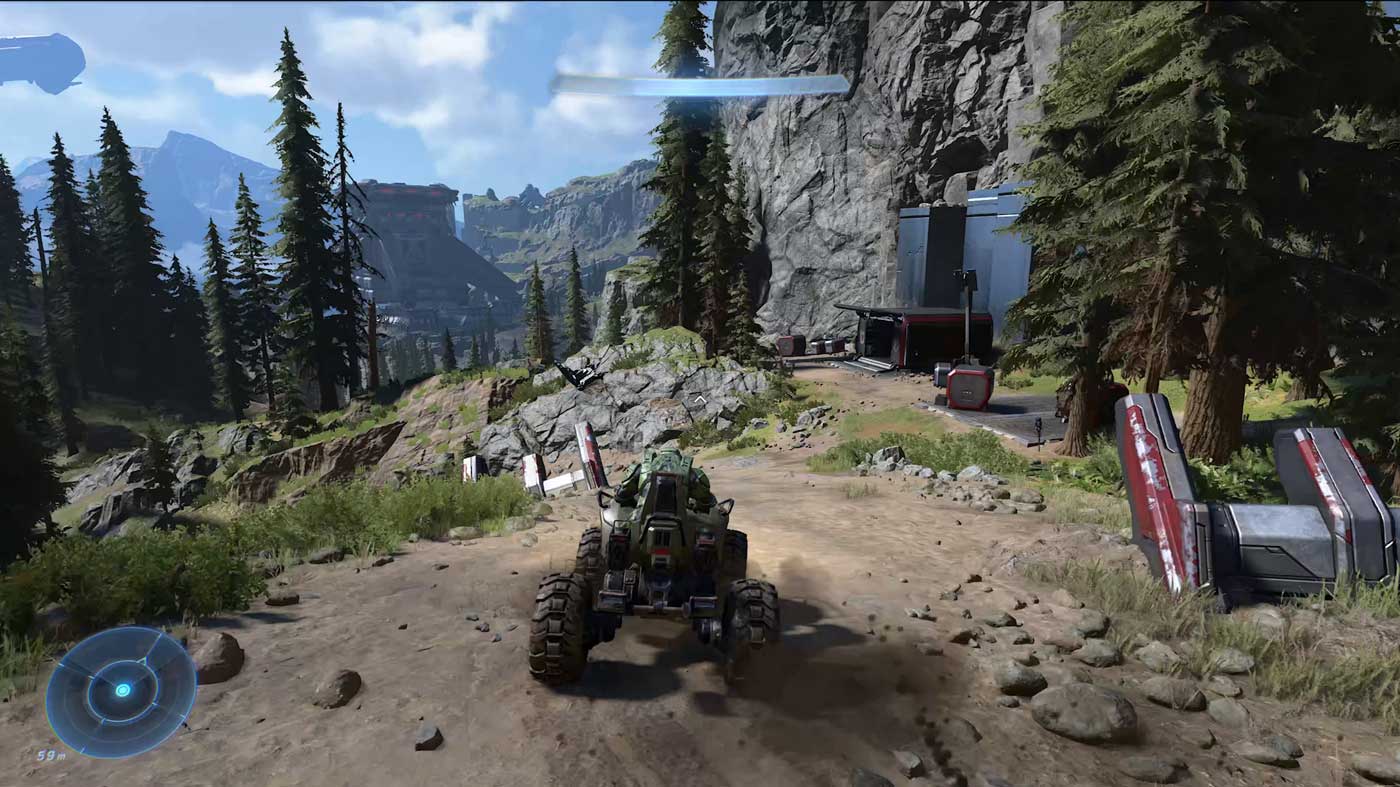
I was speaking to the Forza Horizon team a month or so ago and they were really open about some of the challenges about developing for the Xbox One alongside the Xbox Series X. I’d love to know about some of these challenges that the team faced when developing Halo Infinite for such a huge amount of platforms.
JS: Yeah, absolutely. Another one of the principles that I talked about when I came on was designed parity on all platforms, which is to say if you’re running on an Xbox One versus a brand new Xbox Series X that we’re not going to do things like strip out A.I. on Xbox One, or change weapon parameters, or basically get to performance by reducing the design of the game. We committed ourselves to the idea that no matter what platform you play on, it’s the game. And we’re going to find trade-offs in other areas to make it run and run well on low-spec devices. But having made that decision, then that unlocks a whole bunch of, okay, well, let’s come together and let’s get it done.
The other thing that I did and encouraged other people on the team to do, is just play the game on an Xbox One or play the game on a min-spec PC. And in fact, for the last six or so months of the game’s development, that’s all I played the game on. I just played the game. I got daily builds on Xbox One and a low-spec PC. Of course, I was checking it on all the other platforms too, but I just wanted to put myself in the shoes of the majority of our customers, this is how they’re going to experience the game. Let’s make it great. Let’s make it really great for them. And you know, once you commit yourself to those principles, I think it’s a lot easier to lead into and to make the game as great as it can be.
This is the biggest Halo campaign we’ve ever made. It’s the most wide-open, expansive environment. And yeah, that’s challenging to get running performantly on a Durango – sorry, Xbox One – but we did. And if you play the game’s campaign today [on Xbox One], it’ll be 30 frames a second. It’ll be a lower screen resolution than what you’ll get on more modern hardware, but it’s a great playable fun experience. That’s the exact same game design-wise as any of the other platforms.
I love talking to Xbox Games Studio teams because there’s this unique proposition called Game Pass where millions of gamers have access to your game day one without paying any extra. I’d love to know if this changes anything in regards to the creative process and keeping people interested long term because it is really interesting that people just have access to this game without having to drop $100 on day one.
JS: Absolutely right. You know, it’s very different from the olden days where you would ship a game on a disc, and away it would go. I actually love that we’re part of a portfolio of games where people have a ton of choice and that we’re all competing in a friendly, collegial way for players. We know that we’re launching with a bunch of other great games from Forza to Flight Simulator to Age of Empires, and all of the other great third-party stuff and indie titles that are in Game Pass.
I love it that players have choice and that they can fall in love with a small handful of games that they really want to play deeply. I think Halo Infinite has something unique to offer even among first-person shooters, but we know that there’s lots and lots of choice out there.
So as a designer, you absolutely need to put those glasses on. When you look at your game and understand that people’s time is precious and that you need to give them meaningful things to do with their time. And when we looked at Infinite’s campaign specifically, we decided that we would create a more open style of play, a very expansive adventure-filled game, but we didn’t want to require people to play dozens and dozens and dozens of hours to finish the game. We wanted to give people that same great story-driven experience, but just inject a little bit more freedom, a little bit more choice about how people walked along that story path. So, that’s just one example of how we are thinking about Halo Infinite’s campaign sitting in Game Pass, and it’s a whole different conversation when it comes to our free-to-play multiplayer.
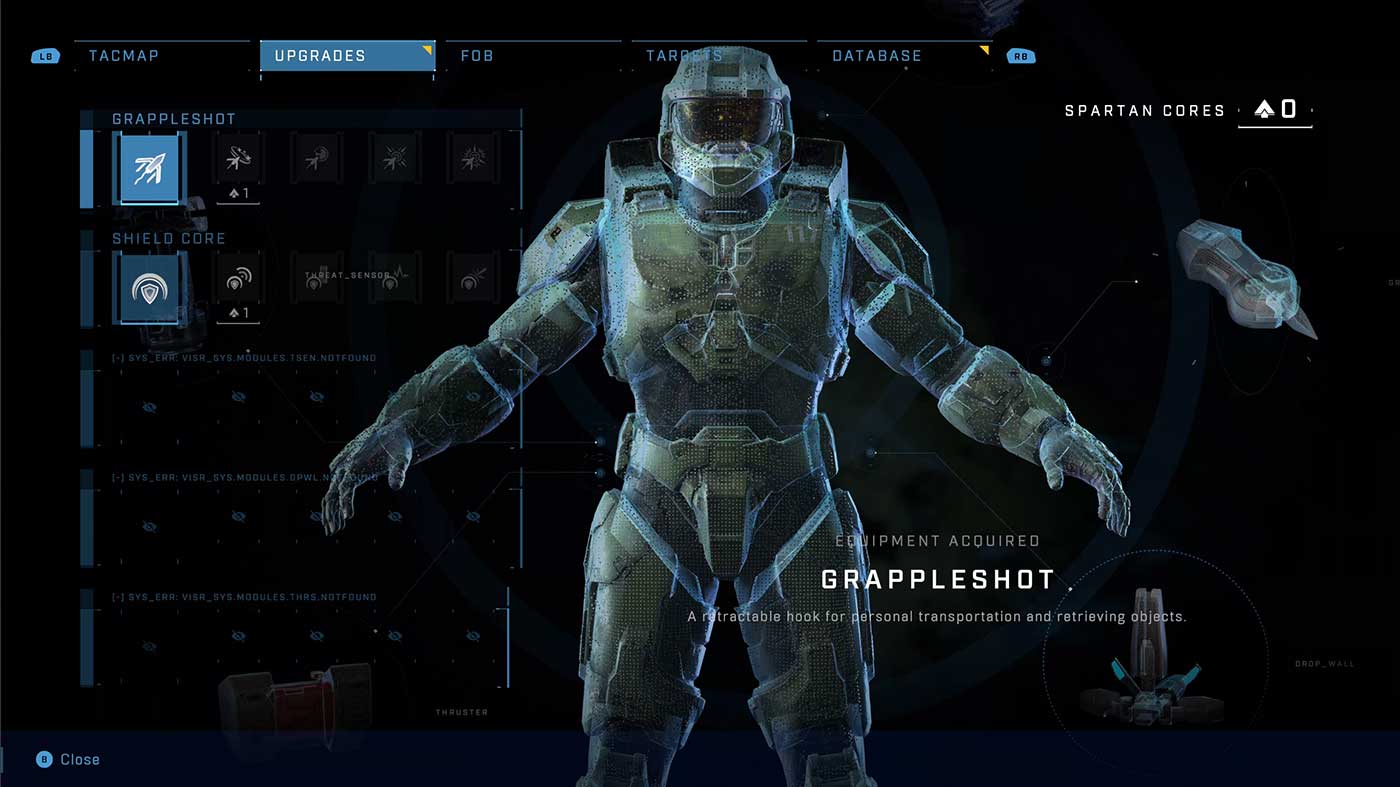
You just touched on it then, but there is an open-world Halo game for the first time. I’d love to know what the team set out to achieve with this initially, and was this something that you personally saw Halo doing earlier, but couldn’t due to time or tech constraints? What was the main decider for the game moving into that space and do you feel like you achieved what you set out to do?
JS: Well, I remember more than twenty years ago now, back in 1998, when I first joined Bungie and I walked into the Halo room and I saw early builds of the game. And one of my first questions that I asked the team was, oh my gosh, here we are in this cool alien valley, what’s over that hill? What’s over that mountain over there? And the response was like ‘Nothing, you dummy! Because that’s the edge of the map.” I’m like, wait, what do you mean? You can’t go over there and you can’t explore? And no, no, no. The world is constrained. We’re in this canyon for a reason. It was always the dream of the team to be able to let players go on an adventure where if they saw a distant hilltop they could climb it.
If they saw a forest, they could explore it. If they saw a chasm or a tunnel leading deeper into the earth, or a strange alien structure that they could open up the door and go and go exploring. Halo Infinite, in many ways, really is that realisation of two decades worth of dreaming. And now we have the creative and technical innovation that allows us to get closer to that vision than we ever have before. Is there still an edge of the world? Well, of course, it’s a video game, but you have so much freedom to explore in Halo Infinite. It’s really quite stunning for a Halo game to see that same tight core combat loop now just populated throughout this world. And the idea that you can take on these really fun multi-leveled complex enemy bases from any angle, bringing in a group of marines, all loaded up with the weapons that you gave them, there’s just that same classic Halo “most powerful actor in a rich physical simulation” combat loop, but also now this 360-degree base assault feel that we’ve never really been able to capture before.
Yes, it really is like twenty years in the making in many ways.
I know that Infinite is planned to be a platform and you probably don’t want to talk about post-launch too much, but do you see this world being expanded on as time goes on? Does the team know what that will look like?
JS: Well, step one is we’ve got to make good on some promises that we’ve made to our players, like delivering campaign co-op and delivering our Forge toolset. We also are really focused on making sure that our multiplayer free-to-play seasons, beyond the first, are filled with a lot of great activities and game modes and maps and other fun surprises. Beyond that we haven’t at least talked about where we’re heading next with the campaign. But, certainly, the technology that we’ve created to enable this version of Infinite’s campaign is giving us a lot of fun things to think about in terms of where we might go next.
Because your background is particularly in storytelling, I’d love to know your take on the open-world and storytelling and how you find that balance when Halo is a story about urgency. How do you ensure that the game remains structured with a good solid narrative that keeps moving forward?
JS: This is one of the things that I’m most proud of in terms of the team’s work. And this was really all designed before I joined the team. This very epic, but at the same time intimate, story that really focuses on the Chief’s relationship with the Weapon and the Pilot, this tight cast of allies and a tight cast of antagonistic characters, there’s a very strong linear story that is the spine of that Halo campaign experience. But what’s wonderful about this game is that you can choose to just go from story mission to story mission. The path is very clear. The game tells you exactly where you need to go, or if you want to be, you can be tempted off that path and go explore that strange cave system or go and check out that alien Banished war base that puts up all its alarms the moment you get close. You can go to that red smoke on the horizon to go try to rescue that group of marines who need you.
There are all these reasons to stray off that story path if you want, but none of it is required. None of it is required to progress a skill tree or anything like that. Everything that you need in the game is right there on the golden path. The stuff that’s off the path is all just extra. It’s all adventure and fun and a chance to enjoy more great Halo combat exploration. So yeah, I think that that decision by the team to make that more expansive world content optional, and not make it a requirement to progress, I think it was a really smart decision and lets the game still feel in many ways like a classic Halo game that’s story-driven.
Some of the original Bungie team went on to create incredible open-world experiences in Destiny. Did the team look there for inspiration in terms of how to take this great world into the open space, for both now and even for the future of the platform?
JS: I would say yeah. Not only do we look at Destiny, but certainly when it comes to multiplayer, we look at other great free-to-play experiences that are out there in the world.
Yeah, I think that’s where most of the research and thinking went into, which is how do we take Halo Infinite’s multiplayer and build it into a free-to-play service that not only appeals to our great fans that have been with us for years but also slopes the floor, lowers the friction for new people who maybe have never tried a Halo game before. It’s been a while since the Halo game came out – at least a modern Halo game, not The Master Chief Collection. We’re very conscious through Game Pass, and now releasing day one on PC, that we had the opportunity to find a whole new audience for Halo, as well. So I would say the bulk of the thinking that we did went into that area.

Something from the first few hours of the game, I’d say you really broke down Master Chief. He’s obviously challenged emotionally and physically by the Banished. Was one of your main focuses to give him some depth through vulnerability?
JS: Yeah, absolutely. You know, from taking his armor that you might’ve seen in previous trailers for the game and really just beating the heck out of him, giving him dings, dents, and scratches really make him feel like a soldier who’s been through twenty years of really tough combat. We’ve put Master Chief in a position where he doesn’t know everything, where he doesn’t have all the answers, and where there are big gaps in his memory, right? He doesn’t have a crystal clear understanding of the world, he’s at a disadvantage. I think heroes are always more interesting when they can get knocked down and stand back up again and fight for what they believe in. I mentioned earlier that this is both an epic and a more intimate story. And this is really what I’m talking about.
Master Chief is still that same stoic man behind the golden visor, but with a sense of humour, but I think you’re seeing sides to his personality where the years and the conflict are weighing on him. He’s had to make very, very tough choices and he hasn’t come to terms with all of them yet. And we’re still staying true to his character, who he is at the core, but I think we are showing you sides to him that are different. And also, Steve Downes, who voices Master Chief, we’re all getting older. I think there’s a quality to Steve’s performance where Master Chief just sounds more experienced, more weathered, and maybe in a position where he wants to ask deeper questions. But again, it’s still a fun, sci-fi action story, but it’s nice to hear you picking up on some of those intentions of the team.
And obviously the Grappleshot. I couldn’t imagine playing a Halo game without it now. How early did that become a focal point of the core loop, and how did you personally feel the first time you got your hands on it?
JS: Made perfect sense. I mean, the very first time I played the game fifteen or sixteen months ago, when I joined the team, and realised the Grappleshot was in there, it instantly became clear that the Grappleshot paired with all the other equipment really was this a fourth leg of what had typically been a three-legged stool.
And I’m sure you’ve heard us talk about, during Halo gone by, this three-legged stool of grenades, weapons, and melee attack. That’s just the meat and potatoes of Halo’s combat. But I think now equipment is like you said with the Grappleshot, you can’t imagine playing without it now, whether it’s pinging a Jackal’s shield or using it for traversal, or picking up a distant object, like a grenade in the battlefield. I mean, it’s just such a useful tool. I think it matches perfectly for the kind of game that Halo is, as a very kinetic, physical sandbox game. It’s just another great tool in the sandbox.
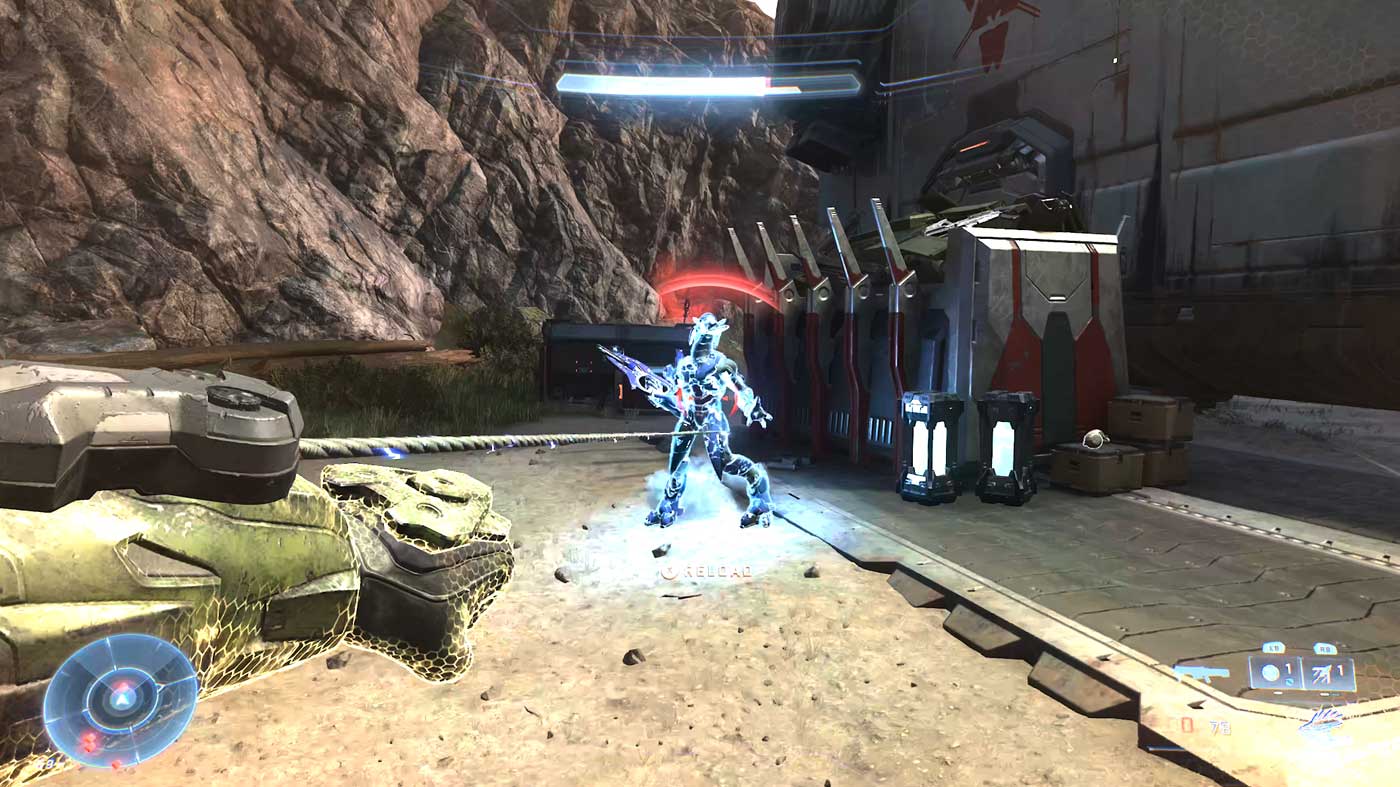
We touched on it briefly earlier, but the open-world does feel like it was begging to be played in co-op. How is that progressing and why was the decision made to hold this back from launch? Was it a call made just due to timings?
JS: It goes back to principles.
We decided early on, when I came back, that we were going to ship experiences when they were ready. And that means they needed to be ready for everyone, on all platforms. And co-op was one of those things that, as we looked to prioritise the time that we had leading up to launch, I would say that was, that was the most painful decision was to choose to delay co-op to post-launch. I mean, Halo games are meant to be played together. They always have been, we understand that deeply. We are equally frustrated that it is not there at launch and we’re working really, really hard to get it into players’ hands as soon as we can.
It might be hard for you to talk about having only returned to Halo a year ago, but was there anything that the team learned from developing Halo 5: Guardians that they took into creating this game?
JS: Well, I would just point back to the story on the campaign side. One of the key takeaways from that game was we want to make sure that when people jump in and play, whether you’re a long-time fan or a brand new fan, that there’s a low barrier to entry and that you shouldn’t feel like you need to go and explore a story outside the game to enjoy the story that you’re playing.
Certainly, if people come to Halo Infinite with a larger understanding of the lore, if they’ve played previous Halo games, they’re going to have an even richer experience. But if you just jump in and you know little to nothing about Halo, we’re really hoping that this spiritual reboot style of game, where we aren’t retelling the first Halo game, but we are telling a story that’s a lot like the first Halo game, that it will help slope the floor for people, really bring them in, and get them up to speed, let them start enjoying the story really, really quickly. So that was one of many lessons that I think the team took away from Halo 5.
Just quickly touching on multiplayer. I’d love to ask about the surprise drop because that was an awesome moment. When was the decision made and how did that come about?
JS: Well, the decision was made a while back and we almost kept it completely under wraps until the last 72 hours. But we knew all along that this 20th anniversary was a great moment for us to do something special for the fans, to really thank people like the long-time Halo fans. It definitely took some extra work to make sure it all lined up well, but I mean, it was a real pleasure just to pull that off and to deliver a really fun anniversary gift to players. I think it’s really important to emphasise that this truly is a beta, you know, we are taking learnings on a daily basis. That’s why people kept interrupting this interview. Like, what are people doing? What behavior have we seen that’s positive, what do people like? What do they not like?
What does our data show? What does telemetry show us? What about social sentiment? You know, where is the game headed? We really want to emphasise to people as we did during the multiplayer technical previews, this is real. This is us listening to you and getting your feedback and starting this journey together where we’re going to evolve and improve the game experience over time. So, yeah, we’re just really happy to have this opportunity three weeks before December 8th, and the game launches officially, to jump in with players and fine-tune the multiplayer experience as best we can.
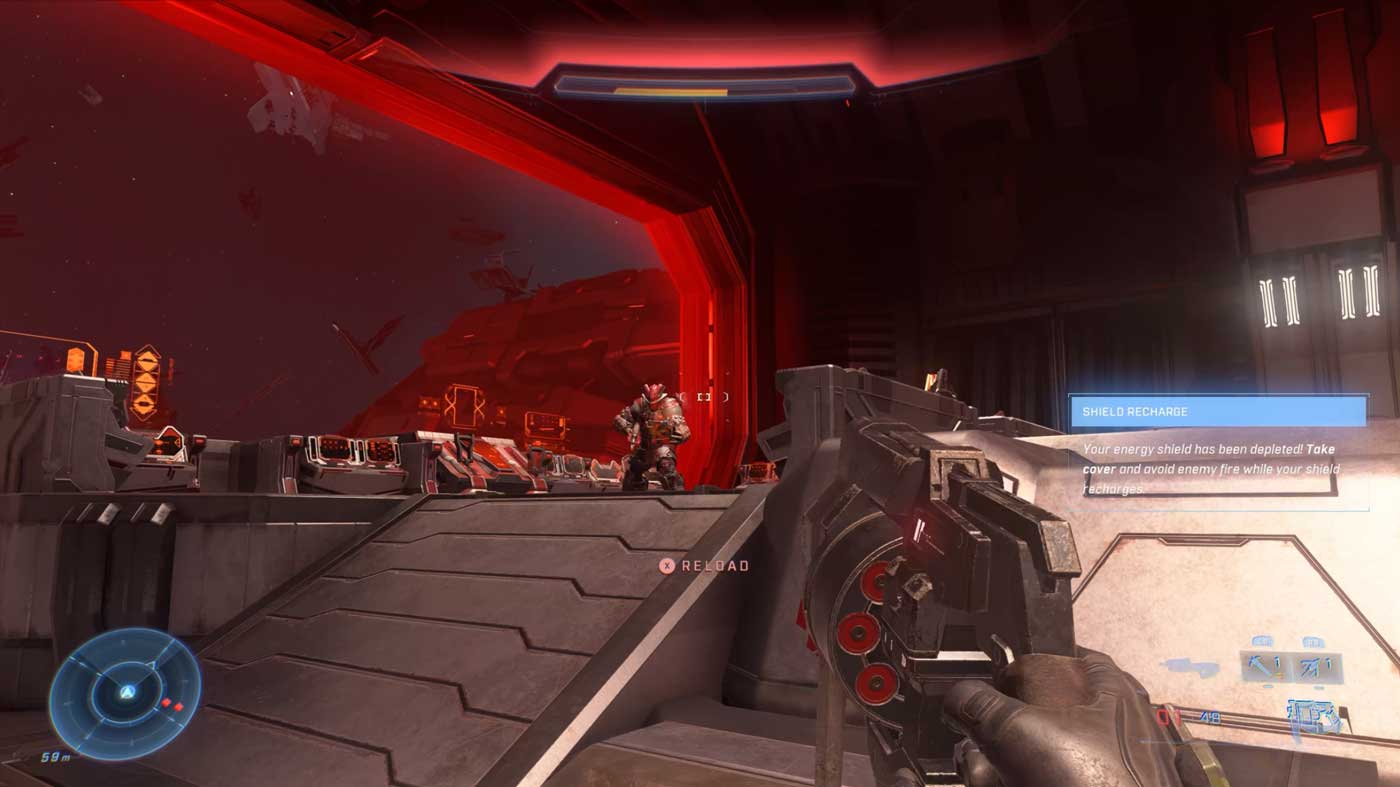
I assume the team is ecstatic with the early response? it’s been almost exclusively positive.
JS: I mean, the core Halo combat experience continues to be super fun and, I think, unique among first-person shooters in many ways, just being able to jump in with completely fair starts, and not worry about load-outs or choosing a hero, and just jump into the map and everybody has a chance to grab a weapon and compete. I think that’s just a classic Halo style of play. I hope it resonates with a lot of people, but although it’s very kind of you to say that the reception has been very positive, that’s not entirely true.
I think people have legitimate concerns about parts of the game. And, you know, we’re really eager to hear that feedback as well. You know, we know it’s a marathon, it is not a sprint. And we hope people play, enjoy themselves, give us lots of feedback and we’re just going to keep on making it better.
Is the idea that there will be some changes before launch, or is the idea that you’re just taking those learnings to implement changes over the next five-to-ten year lifespan of the platform?
JS: I mean, I can’t comment today on any sort of timing, but absolutely we recognise there are more acute issues and less acute issues and we’re going to do everything we can to jump on those acute issues as quickly as possible.
No doubt there is a group of players that are only in it for the campaign and I think the team has been pretty clear in the fact that these are separate experiences? Has there been anything done to lure those campaign players over to multiplayer this time?
JS: Yeah. I mean, if you enjoy Halo’s combat when playing in the campaign, it is going to make you a better, more capable multiplayer player. And we have small things, like in the campaign, you’ll see that you can find exclusive pieces of multiplayer cosmetic gear that you can collect and use in multiplayer. But the biggest investment that we’ve made is on the tutorialisation side where, when you jumped into multiplayer for the first time ever, we have what we’re calling the Academy experience, which is a nice in-depth tutorial about how to play the game, complete with weapon drills that get you up to speed on how weapons handle. And maybe most importantly, we have bots for the first time in Halo.
And if you played it in the multiplayer technical previews, I think they’re actually some really, really good bots when you look across the industry. There’s a ton of ways to customise games against bots, get yourself up to speed, basically get yourself comfortable with what it feels like to jump into multiplayer. And then of course, inside multiplayer we have ranked and non-ranked playlists. So, more than we’ve ever done before, we’re trying to slope the floor for campaign players into multiplayer and vice versa.
Was there any concern about launching within days of two of the biggest first-person shooter games internally? Do you think this is good for the industry and gamers and was it purely just about sticking to that 20th anniversary and the importance of that date?
JS: Yeah, I’d say we know that there are lots of other great games you can play, Forza being one great example. Our hope is that things like Game Pass give people a lot of choice to jump in and play the games that they love. We certainly encourage people to go out and play other great shooters like Battlefield. And if they come and play Halo, we hope that they enjoy themselves and see that the two experiences are very different and there’s a lot to love about both of them.
Halo Infinite’s campaign launches on December 8th on Xbox Game Pass for Xbox Series X|S, Xbox One and Windows 10 PCs. The multiplayer component is currently free to play right now on those same platforms.


